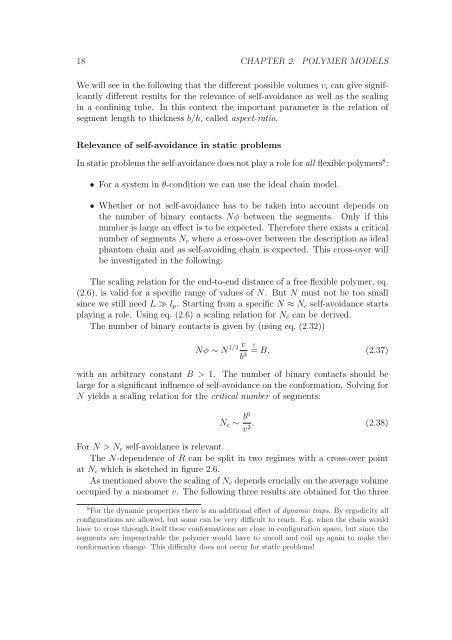Polymers in Confined Geometry.pdf
Polymers in Confined Geometry.pdf
Polymers in Confined Geometry.pdf
Create successful ePaper yourself
Turn your PDF publications into a flip-book with our unique Google optimized e-Paper software.
18 CHAPTER 2. POLYMER MODELS<br />
We will see <strong>in</strong> the follow<strong>in</strong>g that the different possible volumes vi can give significantly<br />
different results for the relevance of self-avoidance as well as the scal<strong>in</strong>g<br />
<strong>in</strong> a conf<strong>in</strong><strong>in</strong>g tube. In this context the important parameter is the relation of<br />
segment length to thickness b/h, called aspect-ratio.<br />
Relevance of self-avoidance <strong>in</strong> static problems<br />
In static problems the self-avoidance does not play a role for all flexible polymers 8 :<br />
• For a system <strong>in</strong> θ-condition we can use the ideal cha<strong>in</strong> model.<br />
• Whether or not self-avoidance has to be taken <strong>in</strong>to account depends on<br />
the number of b<strong>in</strong>ary contacts Nφ between the segments. Only if this<br />
number is large an effect is to be expected. Therefore there exists a critical<br />
number of segments Nc where a cross-over between the description as ideal<br />
phantom cha<strong>in</strong> and as self-avoid<strong>in</strong>g cha<strong>in</strong> is expected. This cross-over will<br />
be <strong>in</strong>vestigated <strong>in</strong> the follow<strong>in</strong>g.<br />
The scal<strong>in</strong>g relation for the end-to-end distance of a free flexible polymer, eq.<br />
(2.6), is valid for a specific range of values of N. But N must not be too small<br />
s<strong>in</strong>ce we still need L ≫ lp. Start<strong>in</strong>g from a specific N ≈ Nc self-avoidance starts<br />
play<strong>in</strong>g a role. Us<strong>in</strong>g eq. (2.6) a scal<strong>in</strong>g relation for Nc can be derived.<br />
The number of b<strong>in</strong>ary contacts is given by (us<strong>in</strong>g eq. (2.32))<br />
1/2 v<br />
Nφ ∼ N<br />
b3 !<br />
= B, (2.37)<br />
with an arbitrary constant B > 1. The number of b<strong>in</strong>ary contacts should be<br />
large for a significant <strong>in</strong>fluence of self-avoidance on the conformation. Solv<strong>in</strong>g for<br />
N yields a scal<strong>in</strong>g relation for the critical number of segments:<br />
Nc ∼ b6<br />
. (2.38)<br />
v2 For N > Nc self-avoidance is relevant.<br />
The N-dependence of R can be split <strong>in</strong> two regimes with a cross-over po<strong>in</strong>t<br />
at Nc which is sketched <strong>in</strong> figure 2.6.<br />
As mentioned above the scal<strong>in</strong>g of Nc depends crucially on the average volume<br />
occupied by a monomer v. The follow<strong>in</strong>g three results are obta<strong>in</strong>ed for the three<br />
8 For the dynamic properties there is an additional effect of dynamic traps. By ergodicity all<br />
configurations are allowed, but some can be very difficult to reach. E.g. when the cha<strong>in</strong> would<br />
have to cross through itself these conformations are close <strong>in</strong> configuration space, but s<strong>in</strong>ce the<br />
segments are impenetrable the polymer would have to uncoil and coil up aga<strong>in</strong> to make the<br />
conformation change. This difficulty does not occur for static problems!













